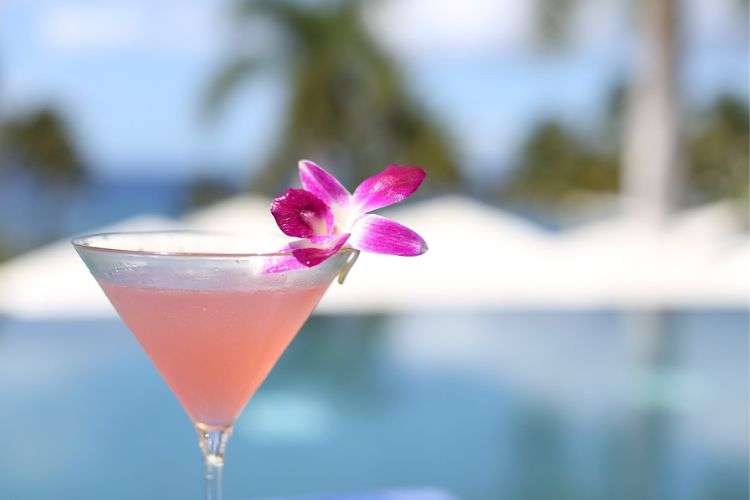To truly excel in the world of mixology, you need more than just a recipe and a shaker. Pro tips for Cocktail Creation, the well-guarded secrets of seasoned bartenders, can make all the difference. As we embark on this cocktail adventure, we’ll explore the invaluable insights and techniques that will set your cocktails apart from the ordinary.
Key Takeaways
- Glassware Matters: The choice of glass impacts the aroma and presentation of your cocktails. Select the right glass for each drink.
- Temperature Affects Taste: Serving temperature matters. It can enhance or detract from the flavour of your cocktail.
- Balance Sweetness and Sourness: Achieving the perfect sweet-sour balance is crucial for crafting a well-rounded cocktail.
- Responsible Drinking: Enjoy cocktails in moderation, offer alternatives to driving, and ensure the safety of your guests.
- Never Stop Learning: Mixology is an ongoing journey. Continually expand your skills and knowledge to create exceptional cocktails.
- Safety First: Adhere to local alcohol laws, stay within your limits, and prioritize the well-being of yourself and your guests.
- Share the Joy: Cocktails are meant to be shared and enjoyed responsibly. Cheers to a flavourful mixology future!
1 Essential Tools and Ingredients
A. The Tools of the Trade
To master the art of cocktail creation, you need the right tools. Here’s a list of essential equipment that every home bartender should have:
| Tools | Description |
|---|---|
| Cocktail Shaker | Essential for mixing and chilling ingredients. |
| Jigger | Ensures precise measurements for consistent taste. |
| Bar Spoon | Perfect for stirring cocktails smoothly. |
| Muddler | Crushes herbs, fruits, and sugar for flavorful drinks. |
| Strainer | Filters out ice and other ingredients when pouring. |
| Citrus Juicer | Extracts fresh juice for vibrant cocktails. |
| Ice Bucket and Tongs | Keeps ice handy for quick chilling. |
| Glassware | Highball, rocks, and martini glasses for presentation. |
| Garnish Tools | Picks and tweezers for adding the finishing touch. |
B. Quality Ingredients Matter
The heart and soul of any cocktail lie in its ingredients. Using high-quality spirits and mixers can elevate your drink to a whole new level. Here’s a list of essential ingredients that should be in your home bar:
| Ingredients | Description |
|---|---|
| Spirits | Choose premium brands for a smoother and richer taste. |
| Fresh Citrus | Lemons, limes, and oranges provide zesty flavors. |
| Herbs and Spices | Basil, mint, cinnamon – for a touch of complexity. |
| Syrups and Bitters | Add sweetness and depth to your cocktails. |
| Quality Ice | Large, clear ice cubes ensure slow dilution and clarity. |
| Fruits and Garnishes | Fresh fruit slices, cherries, and olives for flair. |
C. Selecting the Right Spirits and Mixers
When it comes to spirits, the choices can be overwhelming. Here are some tips to help you pick the right ones:
- Vodka: Opt for a premium, clean, and neutral vodka for versatile cocktails. Brands like Grey Goose and Belvedere are excellent choices.
- Gin: London Dry gin is a classic choice for martinis and gin fizzes. Bombay Sapphire and Tanqueray are trusted options.
- Rum: Light and dark rum serve different purposes. Bacardi and Mount Gay are renowned for their quality.
- Whiskey: Bourbon, rye, and Scotch whiskey each bring unique flavors. Maker’s Mark, Bulleit, and Glenfiddich are highly regarded.
- Tequila: Silver tequila for margaritas, and aged tequila for sipping. Patron and Don Julio are top-notch brands.
As for mixers, fresh is best. Squeezing your own citrus juice and using homemade syrups can make a world of difference in your cocktails. Quality tonic water and soda are also essential for classics like the Gin and Tonic or the Whiskey Highball.
Searching for Mixologist to Spice Up Your Events?
Call us at 087 738 8306 or Fill the form below and we will get back to you ASAP.
2 Mixing Techniques
A. The Importance of Proper Mixing Techniques
Proper mixing techniques are the backbone of exceptional cocktails. They determine the texture, temperature, and overall taste of your drinks. Just as a painter needs different brush strokes to create a masterpiece, a mixologist relies on various methods to craft the perfect cocktail. Here, we’ll explore these methods and how they impact the final product.
B. Different Mixing Methods
Stirring
Stirring is the subtle art of mixing ingredients without agitating them too much. It’s ideal for cocktails that should remain clear and silky, like the classic Martini. Use a long bar spoon and gently stir the ingredients in a mixing glass filled with ice. Stirring blends the elements gracefully, preserving the spirits’ clarity and texture.
Shaking
Shaking introduces vigor to the mixing process. It’s perfect for cocktails that require thorough blending, dilution, and a bit of frothiness, like Margaritas or Daiquiris. Add your ingredients to a shaker with ice, shake vigorously, and strain into your glass. The resulting drink will be refreshingly cold and well-integrated.
Muddling
Muddling is the technique of gently crushing ingredients, typically herbs, fruits, or sugar, to release their flavors. This method is prominent in drinks like Mojitos and Old Fashioneds. Use a muddler to press the ingredients at the bottom of your glass, allowing their essential oils and juices to infuse the cocktail with their distinct essence.
C. Tips for a Well-Balanced Mix
Achieving a well-balanced mix is the holy grail of mixology. Here are some tips to help you strike that perfect harmony:
- Measure Precisely: Use a jigger or measuring cup to ensure accurate proportions. Consistency is key to a balanced cocktail.
- Taste as You Go: Don’t be afraid to taste your concoction as you mix it. Adjust the ingredients if needed to achieve the desired flavor.
- Understand the Spirits: Different spirits have varying flavors and strengths. Familiarize yourself with their characteristics to create complementary combinations.
- Mind the Temperature: Properly chilled cocktails should be served cold, while warm cocktails, like Hot Toddies, should be served at the right temperature.
- Experiment: Mixology is an art, and experimentation is encouraged. Feel free to tweak recipes and explore new combinations to discover your signature cocktails.
3 Garnishing and Presentation
A. The Significance of Garnishes
Garnishes are the finishing touch that transforms a good cocktail into a great one. They not only enhance the visual appeal but also contribute to the overall aroma and flavor of the drink. A well-chosen garnish can be the key to a memorable cocktail experience.
B. Common Garnishes
Here’s a list of common garnishes that can elevate your cocktails:
| Garnish | Description |
|---|---|
| Citrus Twist | Lemon or orange zest adds a burst of aroma. |
| Cherries | Maraschino or brandied cherries for a sweet note. |
| Olives | Classic in martinis, offering a salty contrast. |
| Mint Sprig | Fresh mint enhances freshness and aroma. |
| Candied Ginger | Adds a zing and sweet heat to your drink. |
| Pineapple Wedge | Perfect for tropical cocktails. |
C. Tips for Creative Presentation
Presentation matters. The way your cocktail looks can be as important as its taste. Here are some tips to enhance your presentation:
- Glassware Selection: Choose glassware that complements the cocktail. Tall glasses for highballs, coupe glasses for Martinis, and mugs for warm drinks.
- Ice Matters: Clear, large ice cubes or spheres add sophistication and melt slowly, preserving the drink’s integrity.
- Layering: Experiment with layered cocktails by pouring different densities of liquids over the back of a spoon. It creates an eye-catching effect.
- Creative Rims: Experiment with rimming glasses with salt, sugar, or spice blends for an added flavor dimension.
- Garnish Placement: Place garnishes thoughtfully; they should enhance the aroma and make the drink inviting.
If you are looking to upgrade your Restaurant Skills, then you may join our Online Certification Course here.
4 Flavour Pairing and Recipe Creation
A. The Science of Flavour Pairing in Cocktails
Flavor pairing in cocktails is akin to composing a symphony of tastes. Understanding the science behind which ingredients complement each other can help you create harmonious and memorable drinks. It’s about balancing sweet, sour, bitter, and savory elements to craft a well-rounded flavor profile. Here, we’ll explore the science and art of flavor pairing.

B. Tips for Creating Unique Cocktail Recipes
Creating unique and balanced cocktail recipes is where your creativity as a mixologist shines. Here are some tips to help you invent your own signature cocktails:
- Start with a Base Spirit: Choose a base spirit that you love and want to showcase. Whether it’s whiskey, gin, or tequila, the spirit sets the tone for your cocktail.
- Consider the Flavor Profile: Think about the flavor profile you want to achieve. Do you aim for something sweet, refreshing, or bold and smoky? Your choice of ingredients should align with this goal.
- Balance Sweetness and Sourness: Achieving the right balance between sweet and sour is crucial. We’ll delve deeper into this in the next section.
- Experiment with Ingredients: Don’t be afraid to experiment with various herbs, spices, and fruits. Try infusions and homemade syrups to add a unique twist.
- Garnish Thoughtfully: The garnish should not only enhance the visual appeal but also complement the flavor of the cocktail.
C. Classic and Inventive Cocktail Recipes
Classic: Margarita
- Ingredients:
- 2 oz Tequila
- 1 oz Triple Sec
- 1 oz Fresh Lime Juice
- Salt (for rimming)
- Instructions:
- Rim the glass with salt.
- In a shaker, combine tequila, triple sec, and lime juice with ice.
- Shake well and strain into the prepared glass.
Inventive: Spiced Pineapple Mojito
- Ingredients:
- 2 oz White Rum
- 1 oz Pineapple Juice
- 1 oz Lime Juice
- 1/2 oz Simple Syrup
- 4-6 Fresh Mint Leaves
- A pinch of Cayenne Pepper
- Pineapple Wedge and Mint Sprig for garnish
- Instructions:
- Muddle the mint leaves in a glass.
- Add the rum, pineapple juice, lime juice, simple syrup, and cayenne pepper.
- Fill the glass with ice and stir.
- Garnish with a pineapple wedge and a mint sprig.
5 Balancing Sweetness and Sourness
A. The Importance of Achieving the Right Balance
In the world of cocktails, balance is everything. Achieving the right equilibrium between sweetness and sourness is the foundation of a delicious drink. This balance is often referred to as the sweet-sour mix, and it’s essential to create a cocktail that’s both refreshing and well-rounded.
B. Tips for Adjusting Sweetness and Sourness
Achieving the perfect sweet-sour balance is an art. Here are some tips to help you adjust sweetness and sourness in your cocktails:
- Citrus Juice: Citrus fruits like lemons and limes are your best friends for adding sourness. Adjust the amount of citrus juice to control the tartness of your drink.
- Simple Syrup: Simple syrup, made by dissolving equal parts sugar and water, is a common way to add sweetness to cocktails. You can adjust the sweetness by varying the ratio of sugar to water.
- Balancing Act: Start with a balanced ratio of sweet and sour and adjust as you go. Taste your drink and make incremental changes until it’s just right.
- Use Bitters: Bitters can add a layer of complexity to your cocktail, balancing sweetness and enhancing the overall flavor.
- Experiment: Try different sweeteners like honey, agave nectar, or fruit liqueurs to introduce unique sweetness to your drinks.
C. The Role of Syrups and Citrus
Syrups and citrus play a crucial role in crafting the perfect cocktail. Here’s how they contribute:
- Syrups: Syrups are used to sweeten cocktails and provide a consistent level of sweetness. Simple syrup, made by dissolving sugar in hot water, is the most common type. Other syrups like grenadine or orgeat add distinct flavors and colors to cocktails.
- Citrus: Fresh citrus juices, particularly lemon and lime, add a bright and zesty sourness to your drinks. They also contribute to the aroma and freshness of the cocktail. Squeezing fresh citrus juice is always recommended for the best results.
6 Glassware and Temperature
A. The Impact of Glassware on the Drinking Experience
Glassware isn’t just a vessel; it’s a crucial element in the art of cocktail presentation. The right glass can enhance the aroma, taste, and overall experience of a cocktail. It’s the canvas upon which your drink is painted, and choosing the right one is essential for a memorable cocktail experience.
B. Choosing the Right Glass
Selecting the appropriate glass for a cocktail can significantly impact the drink’s overall appeal. Here are tips on matching the right glass to specific cocktails:
- Martini Glass: The iconic V-shaped glass is perfect for classic martinis and other stirred, spirit-forward cocktails. Its wide surface area allows the drink’s aroma to shine, while the stem prevents the hand’s warmth from affecting the temperature.
- Highball Glass: Tall and slender, highball glasses are ideal for long drinks like the Mojito, Tom Collins, and Highball cocktails. They provide ample space for ice and mixers, maintaining the drink’s effervescence.
- Rocks Glass: Also known as an old-fashioned glass, it’s perfect for drinks served over ice, like whiskey on the rocks or an Old Fashioned. The thick base helps maintain the temperature, and its weight provides stability.
- Coupé Glass: A classic choice for champagne and cocktails served without ice. It’s also great for drinks that are strained, like Daiquiris. The wide, shallow bowl is perfect for showcasing the drink’s clarity.
- Tulip Glass: Often used for aromatic cocktails like the Sidecar or Brandy Alexander. The shape concentrates the aroma and guides it toward the nose, enhancing the overall sensory experience.
- Mule Mug: Designed for drinks like the Moscow Mule, it’s usually made of copper. The metal imparts a unique chill to the drink, and the sturdy handle prevents the heat from your hand affecting the temperature.
C. The Significance of Serving Temperature
Serving temperature is a critical factor in cocktail enjoyment. Here’s why it matters:
- Temperature Affects Flavor: Temperature impacts the perception of sweetness, bitterness, and overall flavor. A too-cold drink can mask subtle notes, while a too-warm drink can accentuate the alcohol’s harshness.
- Chilled vs. Dilution: For drinks served on the rocks, like a Whiskey Sour, proper chilling ensures the drink remains cold without excessive dilution. The right glassware can help maintain this balance.
- Room Temperature Drinks: Some cocktails, like the Hot Toddy, are meant to be served warm. The right glass can insulate the heat and provide a cozy drinking experience.
- Presentation: Glassware can signal the drink’s temperature. A frosted glass for a cold cocktail or a warm, steaming mug for a hot one adds to the visual appeal.
7 Tips for Home Bartenders
A. Common Challenges Faced by Home Bartenders
Home bartenders face their unique set of challenges, from limited space to a less extensive selection of tools and ingredients. Here’s how to overcome some common obstacles:
- Limited Space: Utilize compact bar tools, and organize your space efficiently. Consider a bar cart if you’re short on counter space.
- Ingredient Availability: While you may not have a fully stocked bar, focus on a few versatile spirits and essential mixers. Experiment with what you have.
- Lack of Experience: Building mixology skills takes time. Start with simple recipes and gradually work your way up to more complex cocktails.
- Cocktail Knowledge: Continue to learn and expand your cocktail knowledge through books, online resources, and practice.
B. Building a Home Bar Setup
Creating a functional and stylish home bar doesn’t have to be complicated. Here are some steps to help you set up your space:
- Select a Location: Choose a spot for your home bar, whether it’s a dedicated area, a corner of your kitchen, or a bar cart.
- Essential Tools: Invest in the basics like a shaker, jigger, strainer, and bar spoon. These tools are versatile and can cover a wide range of cocktails.
- Glassware: Acquire a variety of glasses for different cocktail styles, as discussed in the previous section.
- Spirits: Start with a few essential spirits like vodka, gin, rum, tequila, and whiskey. Expand your collection gradually.
- Mixers and Ingredients: Stock up on common mixers like soda, tonic water, and juices. Don’t forget to have some fresh fruits, herbs, and syrups on hand.
- Bar Decor: Add some flair to your home bar with decorative items like cocktail napkins, coasters, and maybe a small plant for a touch of greenery.
C. Resources for Further Learning and Improvement
Becoming a proficient home bartender is a journey of continuous learning. Here are some resources to help you enhance your mixology skills:
- Cocktail Books: Invest in classic cocktail books like “The Joy of Mixology” by Gary Regan and “The Craft of the Cocktail” by Dale DeGroff.
- Online Communities: Join online mixology forums and communities where you can learn from experienced home bartenders and share your experiences.
- Cocktail Classes: Consider enrolling in online or local cocktail classes, where you can receive hands-on guidance from experts.
- YouTube Channels: Many mixologists and bartenders share valuable tips and tutorials on YouTube.
- Practice, Practice, Practice: Ultimately, practice is the best teacher. Experiment with different ingredients and techniques to refine your skills.
8 Safety and Responsible Drinking
A. The Importance of Responsible Alcohol Consumption
While indulging in the world of cocktails can be a delightful and educational experience, it’s equally crucial to understand the importance of responsible alcohol consumption. Cocktails are meant to be savored, not abused. Here, we highlight the significance of making responsible choices when it comes to alcohol.
B. Tips for Safe Drinking and Responsible Hosting
Practicing safe drinking habits and responsible hosting is not only a moral obligation but also a legal one in many places. Here are some tips to ensure both you and your guests can enjoy cocktails responsibly:
- Know Your Limits: Be aware of your own alcohol tolerance and never push your boundaries. It’s okay to say no when you’ve had enough.
- Moderation is Key: Encourage your guests to drink in moderation. Serve cocktails with lower alcohol content for extended gatherings.
- Stay Hydrated: Provide plenty of non-alcoholic beverages like water and soda to keep everyone hydrated.
- Designated Drivers: If your gathering involves alcohol, ensure that there are designated drivers or alternative transportation options available for those who’ve been drinking.
- Offer Food: Serve substantial snacks and appetizers to help slow the absorption of alcohol and provide a more enjoyable drinking experience.
- Respect Local Laws: Familiarize yourself with the alcohol laws and regulations in your area. Ensure you comply with legal serving hours and age restrictions.
C. Promoting Alternatives to Driving
One of the most crucial aspects of responsible drinking is offering alternatives to driving under the influence. Here are some options to consider:
- Designated Drivers: Encourage the use of designated drivers, individuals who commit to staying sober and ensuring that everyone gets home safely.
- Rideshare Services: Promote the use of rideshare services like Uber and Lyft, which provide convenient and safe transportation options.
- Public Transportation: In areas with accessible public transportation, inform your guests about bus or train schedules for a safe journey home.
- Walk or Bike: If possible, choose venues or host gatherings within walking or biking distance from your guests’ homes.
Searching for Mixologist to Spice Up Your Events?
Call us at 087 738 8306 or Fill the form below and we will get back to you ASAP.
Conclusion
As we wrap up this exploration of mixology, from essential tools and ingredients to crafting unique cocktails, understanding the significance of glassware, and promoting responsible drinking, it’s clear that the world of cocktails is a fusion of art and science.
Mixology is a journey of creativity, where experimentation and learning go hand in hand. Whether you’re a seasoned bartender or an enthusiastic home mixologist, there’s always room for growth and improvement. The art of crafting cocktails is a lifelong adventure, one that allows you to continually refine your skills, discover new flavors, and share delightful moments with friends and loved ones.













